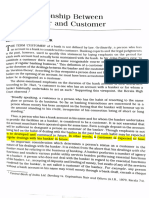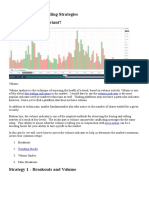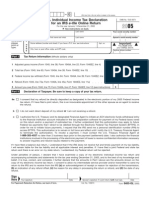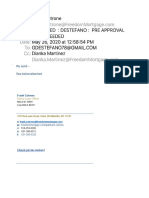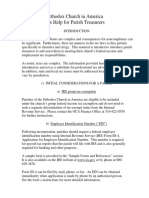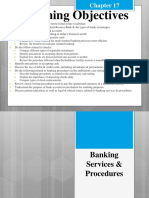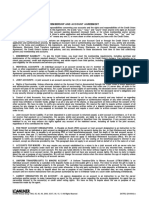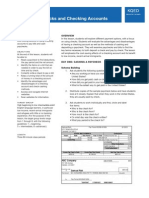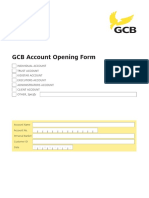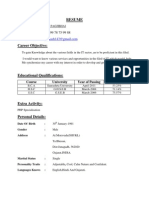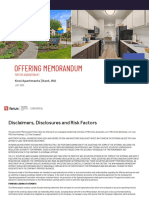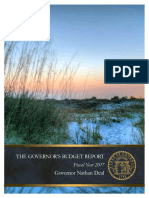General Info
General Info
Uploaded by
dhuni143Copyright:
Available Formats
General Info
General Info
Uploaded by
dhuni143Copyright
Available Formats
Share this document
Did you find this document useful?
Is this content inappropriate?
Copyright:
Available Formats
General Info
General Info
Uploaded by
dhuni143Copyright:
Available Formats
Type of Bank Account:Banks have two basic types of accounts: current accounts Savings accounts.
s. Each bank may have its own names for types of accounts within these categories but the basic principles remain the same. Current Account:Current accounts are used for day-to-day transactions with money coming in, such as wages, and money going out, such as cash withdrawals, bill payments, cheques etc. Current account services Most current accounts offer: a cheque book a cashpoint card standing orders (SO) interest loans. Savings accounts Savings accounts, also known as deposit accounts, are intended for money to be paid in but not often withdrawn. a debit card statements direct debits (DD) overdraft
Some allow instant access to your money but others require that you give the bank notice before making a withdrawal or incur a penalty. They dont offer the same access facilities as current accounts such as cheque books and cash point cards. They usually offer higher rates of interest than current accounts but these too can vary so it is worth shopping around. Individual savings accounts (ISAs) Individual savings accounts or ISAs are a government scheme to encourage more people to save or invest their money without paying any tax on the interest earned nor on any capital gains. With an ordinary bank or building society account you pay tax on the interest you earn. There is a limit to how much you can invest in an ISA each year.
How to choose a bank account
Other issues you may want to consider when choosing a bank are: the location of cashpoints and branches
telephone banking service online banking service can you use other banks cashpoints, do they charge? Saturday or late night opening where can you make cash and cheque deposits personal banking advisers standing orders and direct debits what other services are offered, eg ethical approach to banking, share dealing, small business advice etc. Opening an account To open a bank or building society account, you will usually have to: complete an application form provide proof of your identity and address put some money in the new account. Wherever possible, the bank or building society will want to verify your identity and address through official documents that contain a photo and ideally a signature, for example: A current valid full passport National identity card or driving licence. If you do not have these documents, the bank or building society may ask for other proof of identity. To check the address, the bank or building society may ask for a recent utility or council tax bill. A student may provide a letter from her/his college. The same document cannot be used to prove both identity and address.
Designed to hold your money safely in a bank, but allow you to spend it as you wish. Some earn interest and have restrictions on the number of checks you can write. Most have minimum balances required and penalties for going below that amount. After opening a checking account, you will receive an account number and personalized checks which will be charged to your account. Checks may be written for cash or directly to a business to pay bills or services. You will need identification such as a driver's license or Texas ID card to cash checks. Sometimes, it is difficult to cash checks from a Bryan/College Station bank if you are outside the area, especially outside of Texas.
Cheque book A cheque book is a set of printed forms which allows you to pay amounts of money to a named individual or company.
Clearing cheques
Cheques take a few days to clear in order for the funds to move from one bank to another. There needs to be enough money in the account from which the cheque is paid to cover the amount. Otherwise the cheque will be refused by the bank. This is known as a bounced cheque. Debit cards Another way to pay for things without using cash is by debit card. Debit cards allow for payment to be made in a shop or to a company directly from your current account. Debit cards are not a way to borrow money. Banks dont normally charge for this service. You have to make sure that there are sufficient funds in your account to cover the payment. Debit cards are used with card readers in shops that contact your bank electronically to confirm the transaction. They can also be used to pay for things via the internet or telephone. Cashpoint cards Cashpoint cards allow you to withdraw money from your current account at a cashpoint, sometimes referred to as an ATM (Automated Teller Machine). This provides easy, round-the-clock access to your money. A cashpoint requires a personal identification number or PIN to access the account.
This is a four-digit code which you will need to memorise and keep secret. It is also possible to withdraw money from cashpoints provided by other banks. But be aware that some charge you for doing this. Credit cards Credit cards are not the same as debit or cashpoint cards. Credit cards have a separate account. They allow you to borrow money as well as pay for goods and services. You can apply for a credit card from any provider as well as your own bank. Often banks issue multi-function cards which combine a debit card and cashpoint card in one. For more information about credit cards visit Borrowing. Lost or stolen cards If you lose a debit, credit or cashpoint card, or it is stolen, you must report it to your bank, building society or credit company as soon as possible. You will find a telephone number for reporting lost or stolen cards on the reverse of your bank statement. You will only be liable for a maximum 50 for any criminal use of the card before you report it as missing. You will not have to pay for any misuse of the card after you have reported it. If the card is lost or stolen before you receive it, you will not be responsible for any misuse of the card.
Banks suggest that you never keep your card and PIN number together in case they are stolen. Also you should never tell anyone else your PIN number. Chip and PIN Credit and debit cards contain a small microchip which hold your account details. You are sent a four-digit personal identification number (PIN) separately. Instead of signing when you buy goods in shops you enter your PIN number on a keypad just like at a cashpoint. It is important to keep your PIN number secret to protect your account. For more information visit www.chipandpin.co.uk Overdraft facilities Most bank accounts offer an overdraft facility. This allows you to spend more than the total balance in your account and go overdrawn. It is a way to borrow money short term. You will need to agree with your bank an overdraft limit, for example 100, which would then allow you to borrow up to this amount. An overdraft can be useful if you know that you are about to run out of money but will soon receive some income. Banks charge you interest on your overdraft. This is another percentage rate and varies from one account to another.
You will need to find out from your bank what your overdraft limit is and what interest you will pay to borrow this money. Overdraft charges If you go overdrawn without the banks agreement they may impose charges. Banks and building societies currently charge around 25 to customers who exceed their credit limit, go overdrawn without authorisation, or bounce a cheque. This charge can be made each time a debit is made from the overdrawn account adding up to a large amount of money. Although banks will tell you about these charges it can be argued that excessive charges are unlawful. If this happens to you seek advice. You can find more information about overdrafts in Borrowing. Bank statements A bank statement is a list of transactions made from your account. Your bank will regularly send you a bank statement and you can sometimes obtain one from a cashpoint. The statement will list each transaction in date order show who the transaction is made with show the amount as either a credit (paid in) or debit (paid out) show the total amount of money in your account after all transactions. This is known as the balance.
Your bank statement can be a useful tool for budgeting as it provides a record of your monthly income and spending. You can use it to predict the amounts that will need to be paid in the coming months. Standing orders Standing orders allow you to pay a set amount to another bank account on a regular date, such as on the 10th of each month. You can use this to pay money to companies or individuals or to pay money into a savings account. Direct debits A direct debit is used to allow a company to take amounts from your account, to pay for bills etc. The amounts may vary but will usually be at the same intervals.
You will be informed by the company how much and when the money will be taken from your account. Keep your account in credit You will need to make sure that there is enough money in your account to cover the amounts to be paid by both standing orders and direct debits, otherwise you may become overdrawn. If you have not agreed an overdraft limit with your bank they will charge you for the uncleared direct debit. This can happen more than once and the charges can mount up. Interest The bank pays you for keeping your money with them. This is called interest. It is paid as a percentage rate based on the balance in your account. Interest can be paid on some current accounts and all savings accounts. Interest rates vary so it is a good idea to shop around and compare the interest rates that banks are currently offering. Due to the economic downturn, the bank base rate has been low so as to boost spending rather saving. However this has a knock on effect on loans and mortgages. Calculating interest To calculate interest you multiply the current balance by the interest rate
Example: If you had 100 in a savings account that paid 6 per cent (%) simple interest, during the first year you would earn 6 in interest. 100 x 0.06 x 1 = 6 At the end of two years you would have earned 12. The account would continue to grow at a rate of 6 per year, despite the accumulated interest. Interest is paid on the original amount of deposit, plus any interest earned. Example: If you had 100 in a savings account that paid 6 per cent interest compounded annually, the first year you would earn 6 in interest. 100 x 0.06 x 1 = 6 100 + 6 = 106 With compound interest, the second year you would earn 6.36 in interest. The calculation for the second year would look like this: 106 x 0.06 x 1 = 6.36 106 + 6.36 = 112.36 Telephone and online banking Most bank accounts offer telephone or online banking. Telephone banking allows you to phone a call centre and ask for an operator to make payments and transfers from your account. You can set up standing orders and ask for an update on your account balance. Usually this costs the price of a local call.
Online banking allows you to access your bank account details via the internet and make transactions yourself. It is free, apart from the cost of using the internet. These facilities can help you manage your money more effectively and are useful tools for budgeting. Ask about these options when you choose a bank. Savings accounts Savings accounts, also known as deposit accounts, are intended for money to be paid in but not often withdrawn. Some allow instant access to your money but others require that you give the bank notice before making a withdrawal or incur a penalty. They dont offer the same access facilities as current accounts such as cheque books and cashpoint cards. They usually offer higher rates of interest than current accounts but these too can vary so it is worth shopping around. Individual savings accounts (ISAs) Individual savings accounts or ISAs are a government scheme to encourage more people to save or invest their money without paying any tax on the interest earned nor on any capital gains. With an ordinary bank or building society account you pay tax on the interest you earn. There is a limit to how much you can invest in an ISA each year.
Student and young person accounts Student and young person accounts are designed to help young people and students to get control over their money. Many student accounts have interest free overdraft facilities and have no charges for using the account. There is usually a student adviser to help students with any money management problems. They may also offer a credit card. Student and young person accounts offer incentives like cash payments, mobile phones or gift vouchers, discounts on CDs, DVDs, computer games, concert tickets, books and entrance to night-clubs. Although incentives are tempting they usually apply when you first open the account only. Good interest rates and low charges are usually more helpful in the long run. Graduate accounts offer facilities to assist graduates with their money and debt management for time periods of up to three years after graduation. Choosing a bank account When choosing a bank account, you may find it useful to consider: how much interest is paid when your account is in credit. how much is the interest free overdraft limit. charges for agreed overdrafts and loans these vary.
charges for unauthorised overdrafts. These are overdrafts where you have not received permission from your bank in advance and the charges are much higher. the qualifying period after graduation (to stay in the same account, which will probably have better rates than other accounts). Many of the banks now have an option to move to a graduate account which may also have better terms of interest or charges than an ordinary account, especially if you are still paying off an overdraft or loan. Joint accounts You can open a bank account in your name only or open a joint account with one or more people. This can apply to either current or savings accounts. Some couples decide to do this and agree to have equal access to the funds, regardless of whether they pay in different amounts. Other couples choose to have separate accounts. You could set up a joint account from which bills are paid by direct debit or standing order. Both of you can pay into the account.
STANDING ORDER
DIRECT DEBIT
DIRECT DEBIT
Foreign Currency Exchange - Amount of foreign currency that may be traded for US currency Money Orders - Form of check purchased with cash, often used when sending money by mail (available at banks or post offices).
Draft - Similar to money order; however, the money is deducted from your account instead of being paid in cash. Direct Deposit - Funds are deposited electronically into your account by another institution Credit Union - An institution providing services similar to a bank for its members. There is a fee to become a member FDIC Insured - Protection on your accounts offered by US government for up to $100,000. Banks are not always stable, be sure yours is insured. Service Charge - These are monthly fees the bank withdraws from your account for maintaining it. Credit - A deposit of funds to a bank. Debit - A withdrawal of funds from a bank. Personal Identification Number (P.I.N.) - A security code entered when using an ATM. Charge Back Fee - A processing fee the bank charges a customer for depositing a check with insufficient funds in the account (a hot check).
You might also like
- Relationship Between Banker and CustomerDocument19 pagesRelationship Between Banker and Customerroshxsam1972No ratings yet
- 4 Simple Volume Trading StrategiesDocument49 pages4 Simple Volume Trading StrategiesCharles Barony40% (5)
- VN 04 Credit Cards FaqDocument5 pagesVN 04 Credit Cards FaqdhakaeurekaNo ratings yet
- Negotiable Instruments ActDocument38 pagesNegotiable Instruments ActSonali Namdeo DaineNo ratings yet
- Types of Loans: SecuredDocument9 pagesTypes of Loans: SecuredPaavni SharmaNo ratings yet
- 433-D Installment Agreement: (Taxpayer) (Spouse) (Including Area Code) (Home) (Work, Cell or Business)Document4 pages433-D Installment Agreement: (Taxpayer) (Spouse) (Including Area Code) (Home) (Work, Cell or Business)douglas jonesNo ratings yet
- Account ListDocument2,132 pagesAccount ListDark SightNo ratings yet
- Asterisk-Free Checking Account: 1 Everyday TransactionsDocument3 pagesAsterisk-Free Checking Account: 1 Everyday TransactionsMarcells Danyel JordanNo ratings yet
- US Internal Revenue Service: F8453ol - 2005Document2 pagesUS Internal Revenue Service: F8453ol - 2005IRSNo ratings yet
- Sovereign Man: Nobel Prize-Winning Economist Joseph Stiglitz Says We Shouldn't Worry About America's Prodigious DebtDocument3 pagesSovereign Man: Nobel Prize-Winning Economist Joseph Stiglitz Says We Shouldn't Worry About America's Prodigious DebtrmaqNo ratings yet
- 2.02 Basics of Banking Services Checking AccountsDocument5 pages2.02 Basics of Banking Services Checking AccountsEboni KingNo ratings yet
- CreditcardsDocument22 pagesCreditcardsSandeep AroraNo ratings yet
- Enclosed Destefano Pre Approval Items Needed PDFDocument7 pagesEnclosed Destefano Pre Approval Items Needed PDFGiuseppe DestefanoNo ratings yet
- Chase Online Services AgreementDocument7 pagesChase Online Services AgreementcadeadmanNo ratings yet
- Evidence of Insurance: ProvisionsDocument2 pagesEvidence of Insurance: ProvisionsAnonymous 0Gkzb5100% (2)
- IL-1040 InstructionsDocument16 pagesIL-1040 InstructionsRushmoreNo ratings yet
- FBN App StatementDocument2 pagesFBN App StatementBecca FriasNo ratings yet
- Microsoft Word - Chapter 06 Negotiable InstrumentsDocument9 pagesMicrosoft Word - Chapter 06 Negotiable InstrumentsDuy Trần TấnNo ratings yet
- HK GRCC Platinum - Transfer-In App FormDocument1 pageHK GRCC Platinum - Transfer-In App FormpercysmithNo ratings yet
- Lec 5 - Deposits, Loans and AdvancesDocument39 pagesLec 5 - Deposits, Loans and AdvancesAhmed Munawar100% (1)
- Bank Instructions Application PDFDocument2 pagesBank Instructions Application PDFSanjeet BoroNo ratings yet
- 06-2010 VISA Application 06-2010Document2 pages06-2010 VISA Application 06-2010tredway01100% (2)
- Government Prepaid CardsDocument15 pagesGovernment Prepaid Cardspcheongkyc1100% (1)
- TaxHelpForParishTreasurers OCADocument13 pagesTaxHelpForParishTreasurers OCAConnor McloudNo ratings yet
- 17-Banking Services ProceduresDocument37 pages17-Banking Services Proceduresjay100% (1)
- Veale v. CITIBANK, F.S.B., 85 F.3d 577, 11th Cir. (1996)Document6 pagesVeale v. CITIBANK, F.S.B., 85 F.3d 577, 11th Cir. (1996)Scribd Government DocsNo ratings yet
- Electronic or PDF Remittance Advice Request Form InstructionsDocument1 pageElectronic or PDF Remittance Advice Request Form Instructionsapi-240084111100% (1)
- 0 Ebook 8 Templates 3Document12 pages0 Ebook 8 Templates 3Glenn MozleyNo ratings yet
- Electronic Bank TransferDocument6 pagesElectronic Bank Transfergeorgebates1979100% (1)
- Bank Account Details FormDocument2 pagesBank Account Details FormGaro KhatcherianNo ratings yet
- Apostille/Certificate of Authentication Request: Country Where Documents Will Be Used (Required)Document2 pagesApostille/Certificate of Authentication Request: Country Where Documents Will Be Used (Required)Joshua Gonsher100% (1)
- Organization Registration Checklist: Steps To Complete To Register An Organization Completed?Document3 pagesOrganization Registration Checklist: Steps To Complete To Register An Organization Completed?primeromilitarNo ratings yet
- Account DisclosuresDocument13 pagesAccount DisclosuresDoris Rivera0% (1)
- Understanding Checks and Checking Accounts: Financial LiteracyDocument10 pagesUnderstanding Checks and Checking Accounts: Financial LiteracyElike GyimahNo ratings yet
- Uniform Customs and Practice For Documentary Credit ICC Publication No. 600 (Some Articles)Document10 pagesUniform Customs and Practice For Documentary Credit ICC Publication No. 600 (Some Articles)Мария НиколенкоNo ratings yet
- Oddo Brothers Cpas: William & Regina LittleDocument30 pagesOddo Brothers Cpas: William & Regina Littlebill littleNo ratings yet
- Personal Banking: Consumer Pricing InformationDocument5 pagesPersonal Banking: Consumer Pricing InformationSteph Bryatt100% (1)
- Assignments: Banking and FinanceDocument19 pagesAssignments: Banking and FinanceAamir Hussian100% (1)
- John Doe: Doe" or "Johnny Doe" (For Children)Document7 pagesJohn Doe: Doe" or "Johnny Doe" (For Children)AblutNo ratings yet
- Individual Account Opening FormDocument9 pagesIndividual Account Opening FormAsan Godwin JnrNo ratings yet
- Verification of Reported IncomeDocument3 pagesVerification of Reported IncomepdizypdizyNo ratings yet
- Example Late PaymentDocument2 pagesExample Late PaymentZsuzsa TóthNo ratings yet
- American Express Amex Blue Cash EveryDay Card Benefits and AgreementDocument24 pagesAmerican Express Amex Blue Cash EveryDay Card Benefits and AgreementGreg JohnsonNo ratings yet
- EmbeyaDocument20 pagesEmbeyaCrains Chicago BusinessNo ratings yet
- Telegraphic Transfer GuideDocument12 pagesTelegraphic Transfer GuideBenedict Wong Cheng Wai100% (1)
- Consumer CreditDocument12 pagesConsumer CreditDrpranav Saraswat100% (3)
- CARDHOLDER DISPUTE FORM-Gift 060910Document2 pagesCARDHOLDER DISPUTE FORM-Gift 060910Joseph StricklerNo ratings yet
- Please Use The Checking and Savings Account Application ToDocument3 pagesPlease Use The Checking and Savings Account Application ToGulrana AlamNo ratings yet
- Lettr of CRDocument13 pagesLettr of CRMayank BhatiaNo ratings yet
- Valid Documents List PDFDocument3 pagesValid Documents List PDFVikkiNo ratings yet
- SEC CIK EstadosDocument2 pagesSEC CIK Estadosgiacca90No ratings yet
- N:Fal: : Nam-E - Ro (J:L :: PDocument5 pagesN:Fal: : Nam-E - Ro (J:L :: PChapter 11 DocketsNo ratings yet
- Bank of America Matter Banking ConceptsDocument8 pagesBank of America Matter Banking ConceptsJithendar ReddyNo ratings yet
- Bank Terms RDocument16 pagesBank Terms RVinay SonkhiyaNo ratings yet
- 2021.09.23 - Direct Forgiveness Lender ListDocument31 pages2021.09.23 - Direct Forgiveness Lender ListCharles GoodwinNo ratings yet
- Treasury BillsDocument35 pagesTreasury BillsPatel Akki100% (1)
- New Fresno Fax NumberDocument3 pagesNew Fresno Fax Numberfitness255100% (1)
- Form of Irrevocable Standby Letter of CreditDocument4 pagesForm of Irrevocable Standby Letter of CreditalfarojekltdNo ratings yet
- Sydney's Paid in Full LetterDocument3 pagesSydney's Paid in Full Lettervic30189No ratings yet
- HistoryDocument1 pageHistorydhuni143No ratings yet
- Resume: Contact No: +91 99 78 75 99 88 E-MailDocument2 pagesResume: Contact No: +91 99 78 75 99 88 E-Maildhuni143No ratings yet
- Financial Management: On Real Estate Companies Listed On SensexDocument7 pagesFinancial Management: On Real Estate Companies Listed On Sensexdhuni143No ratings yet
- Prepared By: Pallav Vaishnav Ravi Dave Jigar Vaghasiya Satish Gadhadara Priyank ShahDocument12 pagesPrepared By: Pallav Vaishnav Ravi Dave Jigar Vaghasiya Satish Gadhadara Priyank Shahdhuni143No ratings yet
- Client Information Form - Individual 18-1-2023Document4 pagesClient Information Form - Individual 18-1-2023Shaquille LeeNo ratings yet
- SyllabusDocument3 pagesSyllabuscnvb alskNo ratings yet
- Ankita ProjectDocument32 pagesAnkita ProjectAnkita TiwariNo ratings yet
- Peer 2 Peer Lending (India) Report: Compiled byDocument24 pagesPeer 2 Peer Lending (India) Report: Compiled byPulkit SharmaNo ratings yet
- Warning:: Malek Spinning MillsDocument4 pagesWarning:: Malek Spinning MillsihshourovNo ratings yet
- How To Get Rich Without Being LuckyDocument9 pagesHow To Get Rich Without Being Luckybrijsing100% (1)
- Aquisitions Offering Memorandum The Knol ApartmentsDocument51 pagesAquisitions Offering Memorandum The Knol ApartmentsAli Gokhan KocanNo ratings yet
- Third Party Control Account Segment Qualifier - Case StudyDocument5 pagesThird Party Control Account Segment Qualifier - Case StudySandeepNo ratings yet
- AFF's Tax Memorandum On Finance Bill, 2021Document47 pagesAFF's Tax Memorandum On Finance Bill, 2021ahmad muzaffarNo ratings yet
- Practice Questions Code 313, With AnswersDocument19 pagesPractice Questions Code 313, With AnswersChang QiNo ratings yet
- Corporate Financial Management 5th Edition Glen Arnold Test BankDocument7 pagesCorporate Financial Management 5th Edition Glen Arnold Test Bankderrickjacksondimowfpcjz100% (38)
- Taxi Bill 06.07.23Document1 pageTaxi Bill 06.07.23Sonam GuptaNo ratings yet
- Annual ReturnDocument11 pagesAnnual ReturnBhagwan BachaiNo ratings yet
- 2024 Tax III Module 1 Notes-1Document127 pages2024 Tax III Module 1 Notes-1katelynnewson07No ratings yet
- Written Assignment Unit 2 - Muhamamd YunusDocument5 pagesWritten Assignment Unit 2 - Muhamamd YunusMohidAlamNo ratings yet
- Similarities and Differences Between CAS and NASDocument5 pagesSimilarities and Differences Between CAS and NASSujan KhaijuNo ratings yet
- TDS DocumentDocument34 pagesTDS DocumentSaleem JavedNo ratings yet
- 1eq MathsDocument14 pages1eq MathsASHUTOSH KUMARNo ratings yet
- JohnfordeDocument24 pagesJohnfordeShahrukh2687No ratings yet
- Hengyuan2018 PDFDocument156 pagesHengyuan2018 PDFChee Haw YapNo ratings yet
- Regarding Regarding Regarding Regarding: February 2016Document22 pagesRegarding Regarding Regarding Regarding: February 2016Anil ChawlaNo ratings yet
- Chap 003Document76 pagesChap 003Widya RizkiNo ratings yet
- APGVB NotificationDocument7 pagesAPGVB NotificationkdvprasadNo ratings yet
- Trading Notes CompilationDocument12 pagesTrading Notes CompilationmarkbryanrealNo ratings yet
- Draft Speaking Order ShriramDocument17 pagesDraft Speaking Order ShriramSivasailamNo ratings yet
- RRL-RRS MatrixDocument24 pagesRRL-RRS MatrixWonkyNo ratings yet
- Financial Performance Analysis of Select Cement CompaniesDocument13 pagesFinancial Performance Analysis of Select Cement Companiessanthi samolNo ratings yet
- FY 2017 Georgia Governor's Budget Report PDFDocument444 pagesFY 2017 Georgia Governor's Budget Report PDFmaggieleeNo ratings yet
- GlobanizationDocument16 pagesGlobanizationVidyanand ChouguleNo ratings yet
